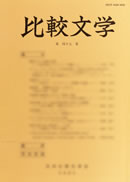38 巻
選択された号の論文の29件中1~29を表示しています
- |<
- <
- 1
- >
- >|
論文
-
1996 年 38 巻 p. 9-21
発行日: 1996/03/31
公開日: 2017/06/17
PDF形式でダウンロード (4009K) -
1996 年 38 巻 p. 22-34
発行日: 1996/03/31
公開日: 2017/06/17
PDF形式でダウンロード (4224K) -
1996 年 38 巻 p. 35-47
発行日: 1996/03/31
公開日: 2017/06/17
PDF形式でダウンロード (4205K) -
1996 年 38 巻 p. 48-61
発行日: 1996/03/31
公開日: 2017/06/17
PDF形式でダウンロード (4204K) -
1996 年 38 巻 p. 62-75
発行日: 1996/03/31
公開日: 2017/06/17
PDF形式でダウンロード (4446K) -
1996 年 38 巻 p. 76-91
発行日: 1996/03/31
公開日: 2017/06/17
PDF形式でダウンロード (5083K) -
1996 年 38 巻 p. 92-104
発行日: 1996/03/31
公開日: 2017/06/17
PDF形式でダウンロード (3919K) -
1996 年 38 巻 p. 248-232
発行日: 1996/03/31
公開日: 2017/06/17
PDF形式でダウンロード (6383K)
学会展望
-
1996 年 38 巻 p. 105-112
発行日: 1996/03/31
公開日: 2017/07/31
PDF形式でダウンロード (1980K)
研究ノート
-
1996 年 38 巻 p. 113-125
発行日: 1996/03/31
公開日: 2017/06/17
PDF形式でダウンロード (3294K)
書評
-
1996 年 38 巻 p. 126-129
発行日: 1996/03/31
公開日: 2017/07/31
PDF形式でダウンロード (1200K) -
1996 年 38 巻 p. 130-133
発行日: 1996/03/31
公開日: 2017/07/31
PDF形式でダウンロード (1226K) -
1996 年 38 巻 p. 133-136
発行日: 1996/03/31
公開日: 2017/07/31
PDF形式でダウンロード (1011K) -
1996 年 38 巻 p. 137-140
発行日: 1996/03/31
公開日: 2017/07/31
PDF形式でダウンロード (1254K) -
1996 年 38 巻 p. 140-143
発行日: 1996/03/31
公開日: 2017/07/31
PDF形式でダウンロード (1362K) -
1996 年 38 巻 p. 144-146
発行日: 1996/03/31
公開日: 2017/07/31
PDF形式でダウンロード (1050K) -
1996 年 38 巻 p. 147-149
発行日: 1996/03/31
公開日: 2017/07/31
PDF形式でダウンロード (808K) -
1996 年 38 巻 p. 150-153
発行日: 1996/03/31
公開日: 2017/07/31
PDF形式でダウンロード (1309K) -
1996 年 38 巻 p. 154-157
発行日: 1996/03/31
公開日: 2017/07/31
PDF形式でダウンロード (1236K) -
1996 年 38 巻 p. 158-162
発行日: 1996/03/31
公開日: 2017/07/31
PDF形式でダウンロード (1644K) -
1996 年 38 巻 p. 162-166
発行日: 1996/03/31
公開日: 2017/07/31
PDF形式でダウンロード (1721K) -
1996 年 38 巻 p. 167-170
発行日: 1996/03/31
公開日: 2017/07/31
PDF形式でダウンロード (1245K) -
1996 年 38 巻 p. 170-174
発行日: 1996/03/31
公開日: 2017/07/31
PDF形式でダウンロード (1480K) -
1996 年 38 巻 p. 174-179
発行日: 1996/03/31
公開日: 2017/07/31
PDF形式でダウンロード (1755K)
雑報
-
1996 年 38 巻 p. 180-183
発行日: 1996/03/31
公開日: 2017/07/31
PDF形式でダウンロード (1279K) -
1996 年 38 巻 p. 184-188
発行日: 1996/03/31
公開日: 2017/07/31
PDF形式でダウンロード (1591K) -
1996 年 38 巻 p. 189-192
発行日: 1996/03/31
公開日: 2017/07/31
PDF形式でダウンロード (1248K) -
1996 年 38 巻 p. 193-197
発行日: 1996/03/31
公開日: 2017/07/31
PDF形式でダウンロード (1332K)
-
1996 年 38 巻 p. 231-219
発行日: 1996/03/31
公開日: 2017/07/31
PDF形式でダウンロード (3201K)
- |<
- <
- 1
- >
- >|
